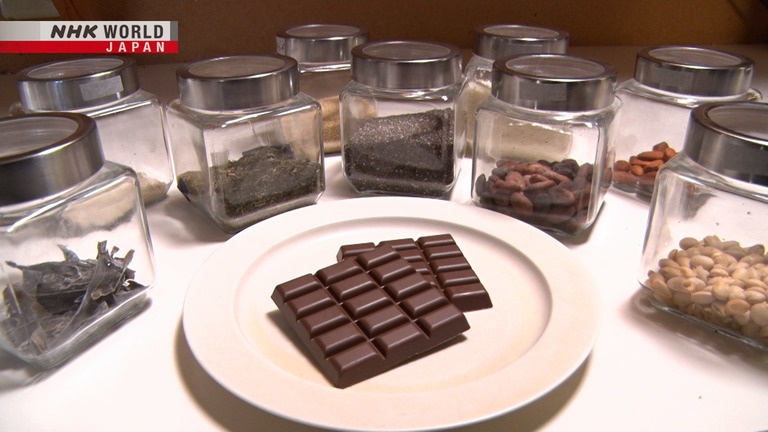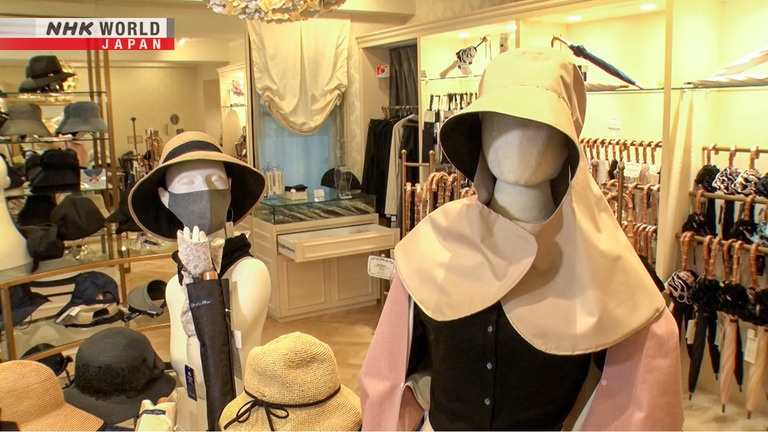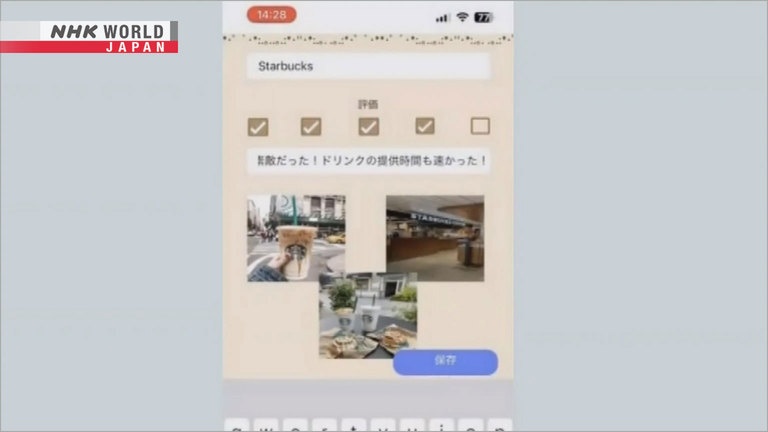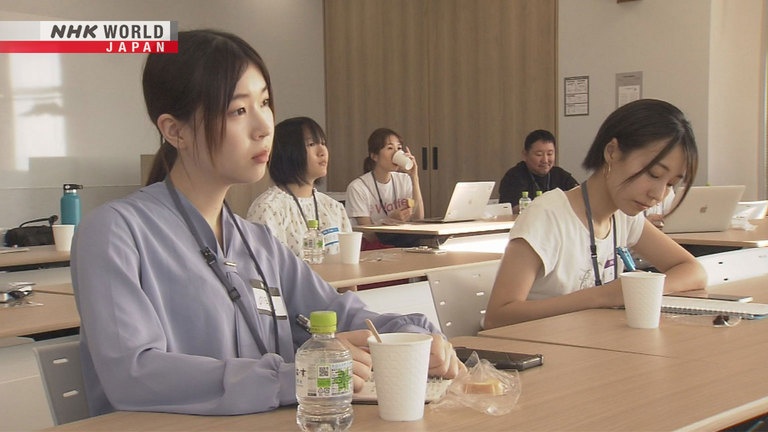In Sickness and in Health
Featuring mild nutrient-packed chocolate bars and a UV-blocking parasol, this week's episode introduces companies that have created specialty products designed for people with specific needs that ended up becoming popular with a much larger consumer base.
*Subtitles and transcripts are available for video segments when viewed on our website.
In Sickness and in Health

Offering a soft texture and containing 29 different nutrients, this chocolate bar was specifically designed for people with a rare skin disorder that can lead to painful blisters inside the mouth and throat

These UV-blocking hats and other products were developed using the advice of customers who suffer from extreme sensitivity to sunlight
Global Trends

Female college students create their own apps in an online seminar aimed at getting more women to work in tech fields

Students were given a tour of a major tech company and met a female systems engineer who could inspire them to take similar career paths
Transcript
Janet Yellen visited China for the first time as US Treasury Secretary.
She stressed that her country is not seeking to decouple from China.
Chinese Premier Li Qiang indicated that Beijing is also looking for ways to improve economic relations.
"When you landed at the airport yesterday, a rainbow appeared in the sky."
"I'm really looking forward to exchanging views with you and discussing topics that interest us."
"We seek healthy economic competition that is not winner-take-all,
but with a fair set of rules that'll benefit both of our countries."
But the nations do not see eye-to-eye on what is fair.
The US is making it harder for China to get key chips.
Washington imposed measures last October that limit China's ability
to purchase or manufacture certain chips that can be used for military applications.
And the administration launched a program in February that will pour billions of dollars into "Made in the USA" chips.
One condition of the subsidies is companies are barred for 10 years from dealings
that would help China increase its manufacturing capacity.
Japan and the Netherlands have yielded to US pressure
and will restrict exports of equipment to manufacture semiconductors.
This expert on international trade says the US is acting out of national security concerns.
"Cutting-edge chips are directly related to military use.
They can be a game changer in military applications,
especially with artificial intelligence and supercomputers.
That is why the US wants to maintain firm control."
China has hit back.
Just days before Yellen's visit, Beijing announced that it would tighten export controls on gallium and germanium -
rare metals essential in making semiconductors.
But Hosokawa says this could be nothing more than China flexing its muscles.
"China has not yet cut off supplies of those metals.
It only added them to a list."
"At this stage, it is just to show that China is keeping a close eye on the US."
China's muted response may have been dictated by its ailing economy.
The troubled real estate sector has been resisting efforts to stabilize it.
And lackluster consumption is a sign that recovery from the pandemic is losing steam.
With the economy on the brink of deflation, Beijing needs to attract investment from overseas.
Yellen summed up her visit to China by saying it put relations on a surer footing.
But there doesn't seem to have been a breakthrough.
"The U.S. and China have significant disagreements.
Those disagreements need to be communicated clearly and directly."
Washington and Beijing both understand the need to strengthen economic ties.
But with Washington unwilling to back down on military-transferable technology,
Yellen's visit only highlighted a crucial gap.
"Let's start."
"Presenting the app you've all been waiting for!"
This programming workshop is for female college students who are interested in tech.
It's an initiative by a nonprofit that aims to increase the ratio of women in the industry.
160 young women have completed the workshop since it started last year.
Many of them are new to programming, but after 2 weeks of online study,
they are able to build their own app.
Omata Hazuki is a freshman.
She created an app to keep track of the cafes she visits and share them with friends.
"I really got into it.
Sciences have always been hard for me, but now this is fun.
I'd like to keep on studying."
"Tech is still a relatively new field, so there is not a much of a wage gap between men and women.
There are other advantages for women in this field."
AI and other emerging fields have created a huge demand for engineers.
The field has been dominated by men worldwide
and men have led much of the research and development.
An example of the problems this can cause is found in facial recognition systems,
which tend to be less accurate in identifying women.
Researchers pointed out that the datasets were biased toward men.
When datasets were updated to make them more diverse - including women, accuracy improved.
A major tech company welcomed students on a tour,
so they can meet female engineers who might serve as role models.
One engineer working on the front lines spoke about her duties and job satisfaction.
"People are really excited about machine learning and generative AI now.
We really need to learn about a wide range of fields, so it's always challenging.
But I find that fun."
The students who participated felt inspired.
"The women here are so cool and it looks like they really enjoy their work."
"It's a dream job."
"We have to have a variety of values and flexible ways of thinking in order to meet diverse needs."
"I think the power of women is needed to make our industry brighter and stronger."
Women currently make up 23% of Japan's tech workforce,
which is about the same as the EU and the US.
This industry with challenging tasks has been dominated by men, but that is changing.
At first glance, this chocolate bar and this parasol look completely normal...
BUT both were designed in response to rare health conditions.
The quality and thoughtfulness they offer, however,
has also made them appealing to average consumers.
Today's On-Site Report features products that were created for people
with specific health care needs that are now resonating with a much larger audience.
Costing about $7 each, these chocolate bars might seem a bit expensive,
but this is no ordinary treat.
It was created by Dr. Nakamura Kosei,
who started his chocolate brand 3 years ago while he was still in medical school.
He decided to use his medical knowledge to develop specially designed products to help his patients.
During his 3rd year of medical school, he met Miyamoto Keiko,
a patient suffering from a rare incurable disease called epidermolysis bullosa -
also known as "EB."
Affecting only 1 in 100,000 people,
it is the result of a genetic mutation that causes the skin to become extremely sensitive and fragile.
Slight bumps or scrapes can cause the skin to bruise and blister.
This can also occur inside the patient's mouth and throat.
Nakamura felt he could help by creating a special food product
made specifically for people suffering from EB, however...
"Miyamoto said, 'don't make a product just for us' -
she was adamant that I didn't make something specifically for EB patients."
"I told him, if you're going to make something for us,
I'd much rather you make something that we can eat anywhere and share with anyone -
be it family, friends, or coworkers."
Those interactions eventually led Nakamura to chocolate.
Easy to share and easy to eat, once in the mouth, it becomes smooth and creamy.
Beyond the texture, Nakamura also wanted to make something rich in nutrients
to help prevent patients from becoming under-nourished.
Initially, he attempted to create a chocolate on his own and tried using 20 different ingredients,
but none of his recipes tasted close to being good enough -
so he turned to a professional chocolatier located in Sapporo for help.
After 6 months of testing,
they settled on a recipe that contained 8 different ingredients including chia seeds, coconut, and... kelp.
In order to ensure a smooth texture, the recipe also calls for large amount of cocoa butter.
The ingredients are then poured into a melanger,
a special grinder used by chocolatiers, for 48 hours,
ensuring that they are finely ground and well mixed into the chocolate paste.
The finished product is a gourmet chocolate bar that doesn't just offer a rich and creamy taste,
it is packed full of fiber, protein, vitamins and healthy fats.
Compact and easily broken into smaller pieces,
customers can quickly and easily enjoy a snack that includes 29 essential nutrients.
"It has a wonderful texture and it's very easy to eat.
But what makes me even happier is that I can enjoy sharing it with other people."
In 2020, Nakamura released the product to the general public via his company's website.
On the label, he added the slogan, "The kindest chocolate in the world."
"It's already made with love and kindness,
but whether it's given to someone to say 'congratulations' or just to cheer them up,
each person who buys one can also include their own feelings of kindness!"
With several flavors now available,
the candy bars are also being sold at over a dozen organic goods specialty shops across Japan.
The chocolates are also proving to be popular with health conscious shoppers and elderly customers.
"I hope we can create a world where both people suffering from health issues
as well as regular people can enjoy sharing the same food at the same time.
Sickness and disease know no borders,
so I want to make our chocolate available to people in the US, Europe, and in other places around the world."
Summers in Japan are sweltering.
One particular brand of parasol is proving to be extremely popular with women of all ages.
Despite costing between $75 and $150,
the company is seeing a steady increase in sales.
One of the main reasons for its success -
the parasols are able to block 100% of UV light.
Featuring a triple-layer design,
the parasol is made using a high density polyester fabric with two layers of polyurethane underneath it.
Third party testing confirmed the company's claims
and showed that absolutely no UV light passes through the parasol.
Starting with parasols, hats, and arm covers,
Oka Chiaki's company has specialized in producing sun-protective goods since 2010.
"I started this company with the idea of creating quality products
that were both fashion and beauty conscious."
About 4 years after going into business,
Oka began to receive feedback from customers who suffered skin conditions
that made them extremely sensitive to UV light.
"We received such a large amount of calls and emails,
we realized we needed to incorporate their suggestions and requests into our products."
One of the customers was Michiko, who has been suffering from photosensitivity for over 20 years.
Even when indoors, inadvertent exposure to sunlight coming in through a window
can result in localized redness and swelling as well as cause her to suffer from fevers and headaches.
She says the items Oka's company produces have become an essential part of her daily life.
In 2015, Oka met with Michiko in person.
After listening to her requests, her company developed a new type of UV light-blocking face mask.
They made the mask wider than usual, to ensure that it offered UV protection up to the wearer's ears.
The mask also incorporates a 3-D design that insures a snug fit.
Lastly, designers chose to use extra-soft cotton lining for added comfort.
"I was really impressed with the company's willingness to listen to clients like me,
and I also love that they make products that aren't just extremely useful,
but are also well-made and stylish."
Since then, the company has continued to listen to its customers' wants and needs
when developing new products, like these UV-blocking pants...
And these shoes which are specially designed to offer maximum protection from exposure to sunlight.
The company is dedicated to putting in the time and research needed
to expand its line-up with useful products.
Oka is confident that by meeting the demands of customers with specific needs,
her company will produce quality products that appeal to a much broader audience
and further add to the brand's reputation.
"If we want to maintain steady growth,
we have to remain focused on creating products that don't just satisfy the average consumer,
but also meet the needs of customers with health-related issues."